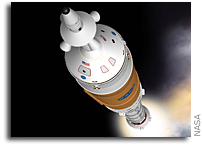GAO: Area I and Orion Project Risk and Key Indicators to Measure Progress

What GAO Found
NASA is currently working toward preliminary design reviews for the Ares I and Orion vehicles. While this is a phase for discovery and risk reduction, there are considerable unknowns as to whether NASA’s plans for these vehicles can be executed within schedule goals and what these efforts will ultimately cost. This is primarily because NASA is still in the process of defining many performance requirements. Such uncertainties could affect the mass, loads, and weight requirements for the vehicles. NASA is aiming to complete this process in 2008, but it will be challenged to do so given the level of knowledge that still needs to be attained. The challenges NASA is facing pose risks to the successful outcome of the projects. For example:
- Both vehicles have a history of weight issues;
- Excessive vibration during launch threatens system design;
- Uncertainty about how flight characteristics will be impacted by a fifth segment added to the Ares I launch vehicle;
- Ares I upper stage essentially requires development of a new engine;
- No industry capability currently exists for producing the kind of heat shields that the Orion will need for protecting the crew exploration vehicle when it reenters Earth’s atmosphere; and
- Existing test facilities are insufficient for testing Ares I’s new engine, for replicating the engine’s vibration and acoustic environment, and for testing the thermal protection system for the Orion vehicle.
All these unknowns, as well as others, leave NASA in the position of being unable to provide firm cost estimates for the projects at this point. Meanwhile, tight deadlines are putting additional pressure on both the Ares I and Orion projects. Future requirements changes raise risks that both projects could experience cost and schedule problems.
GAO’s past work on space systems acquisition and the practices of leading developers identifies best practices that can provide decision makers with insight into the progress of development at key junctures, facilitate Congressional oversight, and support informed decision making. This work has also identified common red flags throughout development, which decision makers need to keep in mind when assessing the projects. They include:
Key indicators: Weight growth is often among the highest drivers of cost growth. Unanticipated software complexity, often indicated by increases in the number of lines of code, can portend cost and schedule growth.
Key junctures: The preliminary design review, critical design review, and production review are key junctures that involve numerous steps and help focus the agency on realistic accomplishments within reachable goals. A disciplined approach aligned with key indicators can provide the knowledge needed to make informed investment decisions at each review.
Why GAO Did This Study
The National Aeronautics and Space Administration (NASA) is in the midst of two new development efforts as part of the Constellation Program–the Ares I Crew Launch Vehicle and the Orion Crew Exploration Vehicle. These projects are critical to the success of the overall program, which will return humans to spaceflight after Space Shuttle retirement in 2010. To reduce the gap in human spaceflight, NASA plans to launch Ares I and Orion in 2015–5 years after the Shuttle’s retirement.
GAO has issued a number of reports and testimonies that touch on various aspects of NASA’s Constellation Program, particularly the development efforts underway for the Orion and Ares I projects. These reports and testimonies have questioned the affordability and overall acquisition strategy for each project. NASA has revised the Orion acquisition strategy and delayed the Ares I preliminary design review based on GAO’s recommendations in these reports. In addition, GAO continues to monitor these projects on an ongoing basis at the request of members of Congress. Based on this work, GAO was asked to testify on the types of challenges that NASA faces in developing the Ares I and Orion vehicles and identify the key indicators that decision makers could use to assess risks associated with common trouble spots in development. The information in this testimony is based on work completed in accordance with generally accepted government auditing standards.








